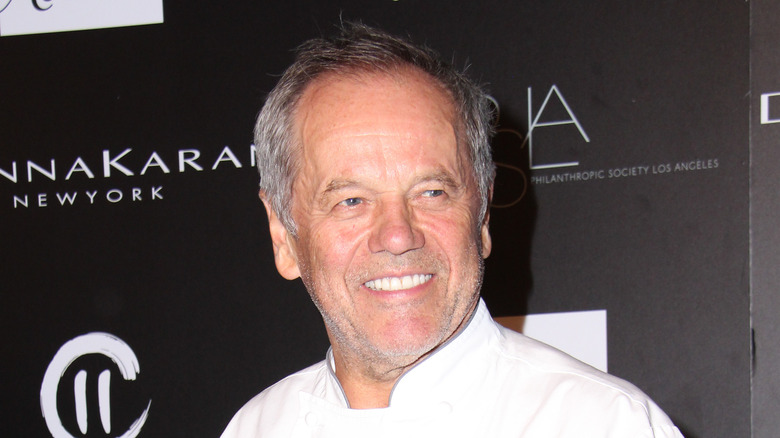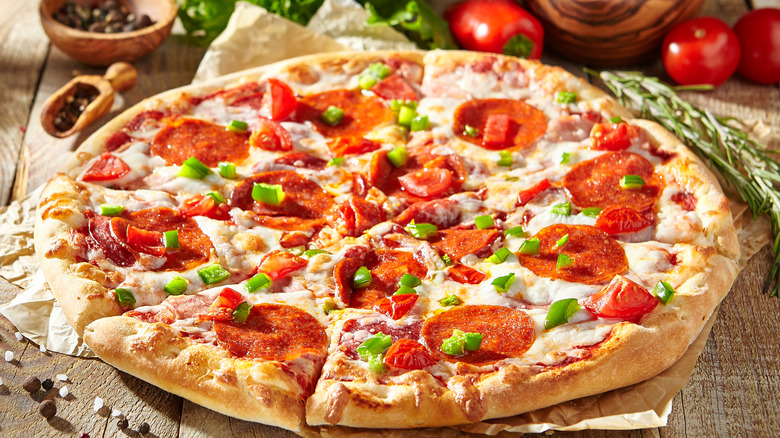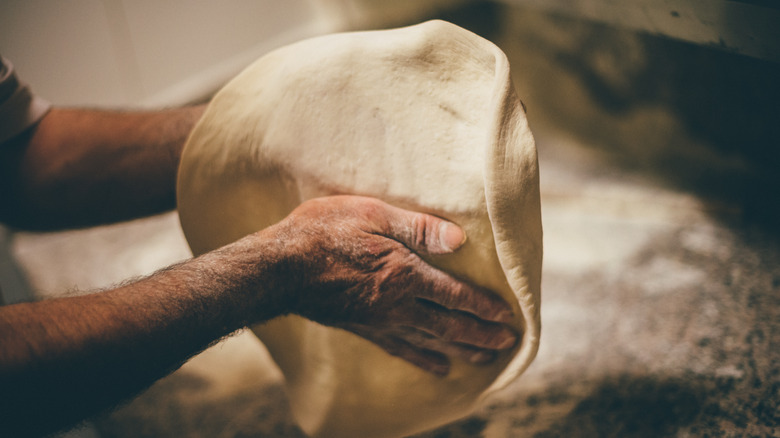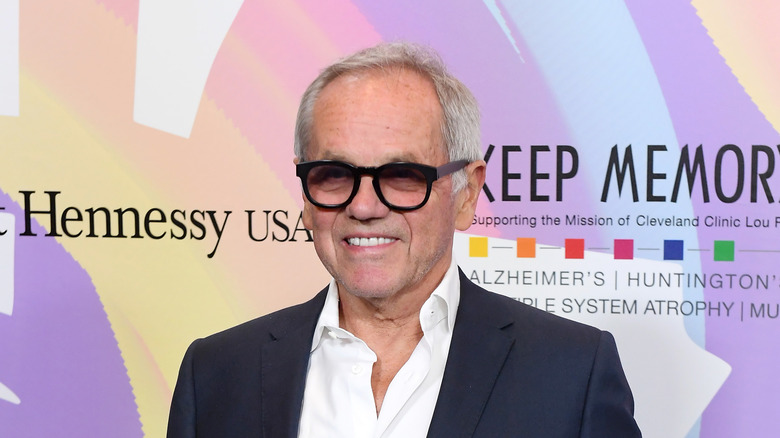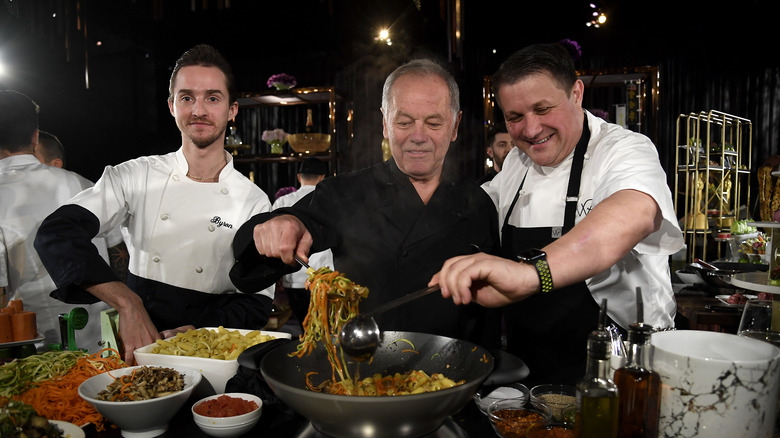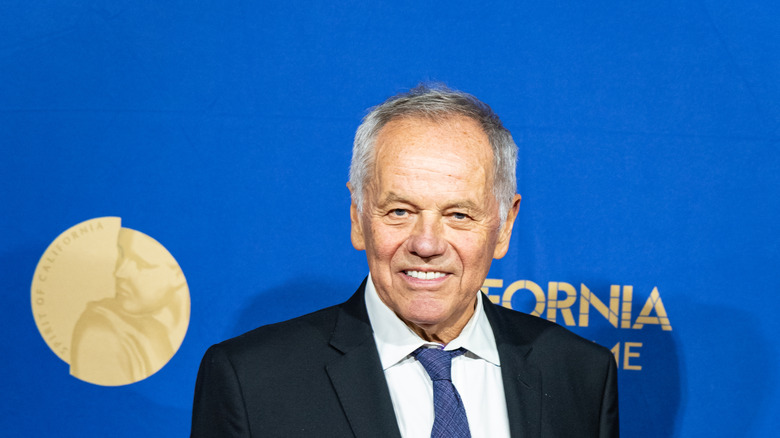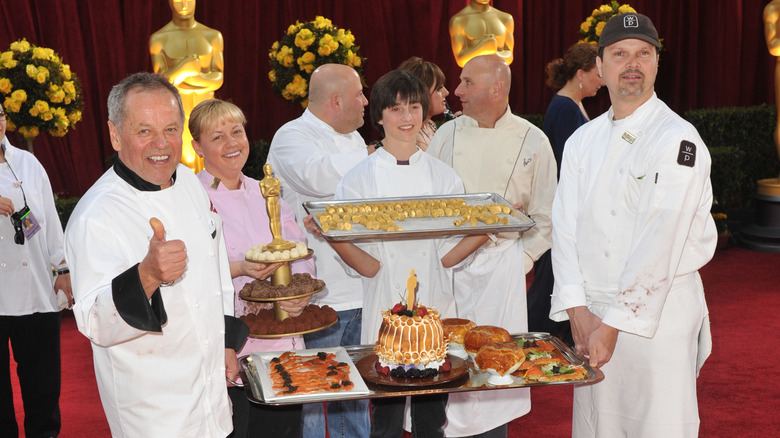The Untold Truth Of Wolfgang Puck's Frozen Pizzas
When Austrian-born chef Wolfgang Puck rose to celebrity chef status in the 1990's, it was in large part because of his radical re-imagining of what a pizza could be, according to the Chicago Tribune. Until he introduced his celebrity clientele at his first restaurant, Spago Hollywood, to pizzas topped with surprising ingredients such as duck sausage and smoked salmon, American diners had a pretty uniform and narrow vision of what pizza was supposed to look and taste like.
Puck was one of the chefs who rejected pizza orthodoxy, turning pizza dough into an edible canvas for self-expression. Recruiting master pizza maker Ed LaDou to lead Spago's pizza program, Puck not only devised his own original pizza toppings but gave LaDou permission to create his own original flavor combinations as well. "It was like being an artist who'd worked with 10 colors all of his life and then got to use 300," LaDou told the Los Angeles Times. Their creations were a hit — and part of the reason reservations at Spago Hollywood were so tough to get. To meet the demands of hungry diners, Puck launched a line of frozen pizzas in 1987, which soon became a staple in the freezers of time-pressed food lovers. Here's the inside story of how Wolfgang Puck's frozen pizzas came to be, how they rose to prominence — and why we don't see them anymore.
Johnny Carson inspired Wolfgang Puck to offer frozen pizzas
Like other top chefs in California, Wolfgang Puck prided himself on using top-quality local ingredients and deeply valued freshness and careful preparation (via California Museum). Thus, it's safe to assume he felt that food was at its best when enjoyed as soon as it's prepared and served — after all, its ingredients would never get any fresher. So when Johnny Carson — one of the many Hollywood A-listers who was a regular at Puck's first restaurant, Spago Hollywood — began ordering multiple pizzas to take home, Puck became curious.
To Puck's shock, Carson replied that he was saving them for himself, explaining that he planned to freeze them to eat later. Puck initially found this idea appalling. Surely, freezing would ruin his creations. But out of curiosity, he tried freezing and reheating one of his pizzas. And to his surprise, it was still quite good — and presented a promising new business opportunity. "That's what gave me the confidence to start the frozen pizza business," Puck told Bon Appétit.
Wolfgang Puck had tried — and failed — to market frozen desserts before
Pizzas weren't Wolfgang Puck's first foray into the frozen food market. As reported by Reference for Business, Puck had previously been approached by Robert Koblin, a Beverly Hills physician and entrepreneur who was interested in starting a line of frozen foods created by top chefs. Koblin eventually narrowed his focus to Wolfgang Puck's creations, resulting in the creation of The Wolfgang Puck Food Company. Their first offerings were frozen desserts based on those served at Spago.
But Puck's exacting culinary standards and insistence on high-quality seasonal ingredients didn't mesh well with the demands of the frozen food market, nor with the expectations of mainstream consumers. "In 1985, we introduced a line of high-quality desserts a la Spago," Tom Warner, then executive vice president of the Wolfgang Puck Food Company, told The Spokesman-Review. "They were excellent products, but they failed because they were so expensive and the ingredients were seasonal." But the company soon found its bearings. In the years to come, as Reference for Business notes, the company would grow to encompass not only a range of frozen foods created by Puck but also Puck's many fast-casual restaurants.
Wolfgang Puck was following a trend toward higher-quality frozen pizzas
Wolfgang Puck's frozen pizzas didn't emerge — or become a hit with consumers — in a vacuum. Puck may not have realized it, but he was part of an emerging trend in the late '90s and early oughts toward higher-quality, more varied frozen food in general (per The Spokesman-Review) and frozen pizza in particular (per Supermarket News). Likely inspired by the success of Puck's unconventional pizza toppings, both restaurants and frozen food manufacturers launched their own experiments and began offering new varieties of pizza. "Everybody's trying to protect their own market share, and they do that by coming up with other varieties," a frozen-food manager at a Midwestern grocery chain told Supermarket News. "Every once in a while, they'll hit on a really good one. If not, they'll try again."
However, frozen pizza manufacturers were doing more than just creating new topping combinations. Realizing their main competition was fresh-baked delivery or takeout pizza, they began focusing on new ways to enhance the quality of their products. For instance, rising-crust frozen pizzas came to dominate the market at this time, and the use of higher-end ingredients, such as smoked mozzarella, was also growing, according to Supermarket News.
His frozen pizzas were originally made by hand by trained chefs
When Wolfgang Puck launched his frozen pizza line, his goal was to offer consumers the same high quality he offered diners at his restaurants. "I think chefs and other people who make good food should take the lead in introducing convenience food with quality to the public,” Puck told the Chicago Tribune. And for him, this meant not only using the same high-quality ingredients and unique flavor combinations as his famed restaurant pizzas, but using the exact same techniques to manufacture them.
Puck's frozen pizzas, like his restaurant pizzas, featured sauces and even sausages made from scratch. And just as in his restaurants, the dough for his each of his frozen pizzas was initially rolled and thrown by hand. So insistent was Puck on maintaining the integrity of his culinary vision that he even put a Chinese chef in charge of stir-frying the topping for his spicy chicken pizza. It was far from the most practical or cost-effective way to mass-produce pizza — but for Puck, quality took priority over efficiency. "If we make canned soup, it has to be the best one, if we make frozen pizza, it should be the best," he told Variety.
His unconventional topping choices got him in trouble with the USDA
Wolfgang Puck's flair for out-of-the-box thinking when it comes to pizza toppings surprised and delighted diners — once-revolutionary flavor combinations such as barbecue chicken have become new standards, and savvy diners no longer bat an eye at the prospect of a pizza without a thick layer of tomato sauce and mozzarella.
But while Wolfgang Puck succeeded in getting American diners to expand their vision of what pizza could look and taste like, he had less success convincing the U.S. Department of Agriculture, which told him he couldn't label his offerings "pizza" unless they contained tomato sauce — which several of his pizzas did not. "We argued and showed them recipes, but we couldn`t win,” Puck told the Chicago Tribune. ”We were going to have to put 'Pizza without tomato sauce' on the label. Then I realized there was no rule about how much tomato sauce I had to use. So I put a guy on the assembly line with an expresso spoon and he adds a tiny spoonful of fresh tomato to each pizza.”
His frozen pizzas and dinners were a hit when they were first introduced
As noted by the Spokesman-Review, Wolfgang Puck's creative pizzas already had a white-hot reputation by the time he launched his frozen pizza line. So when the frozen pizzas were first introduced in 1987, curious eaters unable to travel to or snag a reservation at Puck's famed Beverly Hills restaurant Spago were eager to try them. And judging from the rapid growth of Puck's frozen pizza line — and subsequent expansion into other frozen entrees — diners were pleased with what they tasted. "Our line keeps growing because there's a tremendous demand," Tom Warner, then executive vice president of The Wolfgang Puck Food Company, told the Spokesman-Review. "We have experienced 50% growth every year since we started."
One reason for the success of Puck's frozen pizzas and entrees, Warner said, was quality control: Puck taste-tested and approved every dish in the product line himself. "We took some new pizzas over to Spago and cooked them in the oven there. Wolfgang tasted them and smiled, so I knew we had a winner," Warner told the Spokesman-Review.
But not everyone loved Wolfgang Puck's frozen pizzas
While Wolfgang Puck's frozen pizzas were wildly popular with the public, critical opinion on their quality was mixed. The Chicago Tribune gave them a solid thumbs-up, calling them "trim of crust, subtly flavored and svelte, and praising their "fresh, top-quality ingredients" and "dramatic and classy" packaging, declaring "No other supermarket frozen pizza (and few fresh) can compete with them in taste, quality — or price."
Other tasters, however, begged to differ. A reviewer for the Spokesman-Review panned Puck's spinach and mushroom pizza. "The whole-wheat crust was flat in taste and appearance, more of a cracker than a crust," the reviewer noted. "The cooking instructions advise you to dab the cooked pizza with a paper towel before serving. It drenched my Bounty and helped explain why the veggies were watery and flavorless." And tasters for the Deseret News gave the pizzas lukewarm — but not damning — reviews. "The pizzas are tasty but nowhere near as delicious as his gourmet restaurant ones. These taste like frozen pizzas," one of the tasters said. The second taster expressed similar sentiments. "The best thing about them is their fresh, good-quality ingredients," she noted. "The problem is that it's all kind of plain."
Wolfgang Puck encouraged diners to doctor up his pizzas and make them their own
Wolfgang Puck is not only enthusiastic about inventing, preparing, and serving new dishes, but about sharing his passion for cooking with others. Even before he rose to fame at Spago, he was teaching cooking classes at the restaurant where he worked (he invited Barbara Lazaroff, who would later become his first wife, to one of his classes for their first date, according to People), and he continues to teach an online master class now, according to his website. He has also authored several cookbooks featuring everything from French cooking to healthy cuisine to favorite dishes from his restaurants. In short, he not only wants people to enjoy good food, but to feel empowered to make it for themselves.
This conviction extends even to buyers of his frozen pizzas. While reheating a frozen pizza is one of the most mindlessly unimaginative culinary tasks there is — absolutely zero creativity or skill is needed to fling one into the oven and turn on the heat — Puck recommended a few easy and creative ways home cooks could take his frozen pizzas to the next level. "I like to doctor them a bit," he told the Chicago Tribune. "Add a little basil or chili oil so you feel it`s partly your creation, too.”
In 2002, a new business partnership took Wolfgang Puck's frozen pizzas into the culinary mainstream
As Wolfgang Puck's frozen pizzas grew in popularity, Puck and his management team began to face the challenge of scaling up their operations while staying competitive against established players in the frozen food market. As Reference for Business notes, they were forced to cut ingredient costs to stay competitively priced. And in 2002, Wolfgang Puck made another big move, signing a deal with ConAgra Foods, the producer behind such well-known brands as Healthy Choice, Armour Meats, Marie Callender's and more. Through this deal, ConAgra would produce what it called "the first broad-scale line of wood-fired pizzas available in U.S. supermarkets" using Wolfgang Puck's name and signature flavorings.
The challenge for ConAgra was replicating the unique taste and aroma of a wood-fired pizza on a massive scale and ensuring that the special flavor would survive freezing, transportation, and reheating. ConAgra executives were optimistic. "We believe they deliver the distinctive flavor that comes from an authentic wood-fired oven, along with the unique flavor profile that Wolfgang has made famous, in a pizza you can cook in the comfort of your home," ConAgra CEO Bruce Rohde said in a press release.
Wolfgang Puck didn't approve of how ConAgra was making his pizzas — so he bought back his license
Wolfgang Puck initially had high hopes that his deal with ConAgra Foods would enable him to scale up his frozen pizza operation painlessly and make high-quality frozen pizza easily available to more diners, according to Korn Ferry. And ConAgra seemed to share his commitment to creating a product that met Puck's standards. But the honeymoon between them did not last.
"I sold my pizza business some years ago to ConAgra. I thought, they know better; I would have had to raise the money to expand," he told Korn Ferry. But he soon found out that his idea of a quality pizza and theirs were very different. "But that was one of the worst things I ever did. Because they put some guy in charge who never made a pizza, who never had any idea about pizza. All he knew is that you could make it like the other brands. So we made one like all the others in the supermarket, except it was expensive." Puck, always mindful of quality, didn't want to be associated with a product he didn't respect. So he decided that rather than keep sending substandard pizzas into the world, he'd put his frozen pizza enterprise out of its misery. "So a few years ago, I bought the license back for $250,000," he told Korn Ferry.
Wolfgang Puck's famed smoked salmon pizza wasn't available for reheating at home — until now
Wolfgang Puck's frozen pizzas allowed home cooks to experience some of the unique flavor combinations Puck made famous at Spago — in 2002, topping options included barbecue style chicken, spicy grilled chicken, four cheese and pesto, and Thai-style chicken. But conspicuously absent from his frozen pizza line was Puck's most famous pizza flavor: smoked salmon with crème fraiche and caviar.
Puck's smoked salmon pizza has a star-studded history. According to the Michelin Guide, Puck is said to have invented it on the fly when actress Joan Collins ordered smoked salmon and brioche at Spago, but the restaurant had run out of bread — so he baked a pizza crust, slathered it with crème fraiche and dill, then topped with his house-made smoked salmon and dollops of caviar. The dish became a hit and a staple at the annual Oscars ball Puck hosts at Spago Beverly Hills. It's easy to see why it wouldn't fly as a frozen pizza offering: Its charm comes from the contrast between the hot, crunchy crust and cool toppings, and there's no way to make that happen with a standard frozen pizza. However, you can now order Puck's smoked salmon pizza for home delivery from Goldbelly. You can have two pizzas delivered, with the crusts and toppings shipped with ice packs for you to reheat and assemble. Be warned, they don't come cheap — two pizzas will set you back $116.
